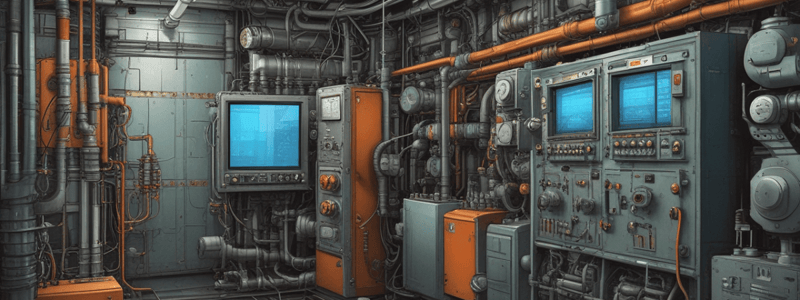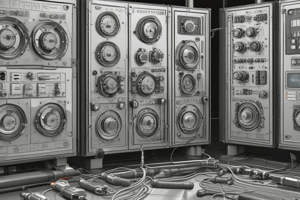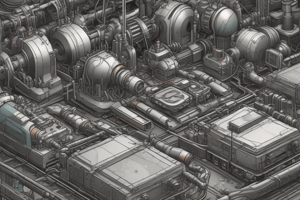Podcast
Questions and Answers
What are the three main steps in a closed loop industrial control system?
What are the three main steps in a closed loop industrial control system?
- Designing the system, implementing sensors, and testing the output
- Programming the system, connecting the devices, and powering it up
- Manufacturing the system, installing it, and maintaining it
- Applying input, controlling the process, and providing feedback (correct)
What is the primary function of a sensor in a control system?
What is the primary function of a sensor in a control system?
- To provide power to the system
- To control the entire system
- To convert the physical quantity into an electrical signal (correct)
- To amplify the signal
What is a transducer?
What is a transducer?
- A device that converts one type of energy to another (correct)
- A device that only converts electrical energy
- A device that only senses changes in physical quantities
- A device that only amplifies signals
What type of transducer converts electromagnetic waves into electric current and vice versa?
What type of transducer converts electromagnetic waves into electric current and vice versa?
What is the function of a tape head?
What is the function of a tape head?
What type of transducer converts motion into electrical form?
What type of transducer converts motion into electrical form?
What type of transducer converts changes in light levels into resistance changes?
What type of transducer converts changes in light levels into resistance changes?
What is a common categorization of transducers?
What is a common categorization of transducers?
What is the primary function of a sensor?
What is the primary function of a sensor?
What type of sensor is a thermistor?
What type of sensor is a thermistor?
What is the purpose of a multiplexer (MUX) in a data acquisition system?
What is the purpose of a multiplexer (MUX) in a data acquisition system?
What is the role of an excitation circuit in a sensor?
What is the role of an excitation circuit in a sensor?
What is the main difference between a passive and active sensor?
What is the main difference between a passive and active sensor?
What is the function of a transducer?
What is the function of a transducer?
What is the purpose of signal conditioning circuitry in a sensor?
What is the purpose of signal conditioning circuitry in a sensor?
What is the main function of a sensor?
What is the main function of a sensor?
What is the role of a data acquisition system?
What is the role of a data acquisition system?
What is the term for the amount that a sensor's output varies when the measured quantity varies?
What is the term for the amount that a sensor's output varies when the measured quantity varies?
What type of sensor is a mercury-in-glass thermometer an example of?
What type of sensor is a mercury-in-glass thermometer an example of?
What is the term for a device that transforms one type of energy into another?
What is the term for a device that transforms one type of energy into another?
What is an actuator?
What is an actuator?
What is the main difference between a sensor and a transducer?
What is the main difference between a sensor and a transducer?
What is the purpose of calibrating a sensor?
What is the purpose of calibrating a sensor?
Why are smaller sensors often preferred?
Why are smaller sensors often preferred?
What is the primary difference between contact and non-contact sensors?
What is the primary difference between contact and non-contact sensors?
What type of sensors detect changes in capacitance?
What type of sensors detect changes in capacitance?
What is the primary function of an optical proximity sensor?
What is the primary function of an optical proximity sensor?
What type of transducers convert sound waves into electrical signals?
What type of transducers convert sound waves into electrical signals?
What is the primary application of Hall effect sensors?
What is the primary application of Hall effect sensors?
What is the output voltage of a D.C. tachogenerator?
What is the output voltage of a D.C. tachogenerator?
What is the main advantage of non-contact sensors over contact sensors?
What is the main advantage of non-contact sensors over contact sensors?
What is the purpose of a photodetector in an optical proximity sensor?
What is the purpose of a photodetector in an optical proximity sensor?
What is the primary function of contact type switches?
What is the primary function of contact type switches?
What is the main difference between A.C. and D.C. tachogenerators?
What is the main difference between A.C. and D.C. tachogenerators?
What is the function of light transducers?
What is the function of light transducers?
What is the purpose of hall effect sensors?
What is the purpose of hall effect sensors?
What is the main application of vibration transducers?
What is the main application of vibration transducers?
What is the function of magnet type switches?
What is the function of magnet type switches?
What is the purpose of electromagnetic type switches?
What is the purpose of electromagnetic type switches?
What is the primary function of tachogenerators?
What is the primary function of tachogenerators?
Flashcards are hidden until you start studying
Study Notes
Introduction to Industrial Control Systems
- A closed-loop industrial control system consists of three steps: applying the input (reference value), controlling the process, and feedback (negative feedback) that measures the output and applies it back to the input stage.
- Sensors are special devices that sense changes in the controlled physical quantity.
- Transducers are devices that convert one type of energy into another.
Types of Transducers
- Electromagnetic transducers:
- Convert electromagnetic waves into electric current and vice versa (e.g., antenna, cathode ray tube (CRT))
- Convert electrical signals into visual form (e.g., CRT)
- Convert electrical power into visible light (e.g., fluorescent lamp, light bulb)
- Electrochemical transducers:
- pH probes
- Electro-galvanic fuel cell
- Hydrogen sensor
- Electromechanical transducers:
- Electro-active polymers
- Galvanometer
- Micro-electromechanical systems (MEMS)
- Rotary motor, linear motor
- Vibration powered generator
- Electrostatic transducers:
- Electrometer
- Photoelectric transducers:
- Laser diode, light-emitting diode (convert electrical power into forms of light)
- Photoresistor, phototransistor, photomultiplier tube (convert changing light levels into electrical form)
- Thermoelectric transducers:
- RTD (Resistance Temperature Detector)
- Photodiode
- Thermocouple
- Peltier cooler
- Thermistor (includes PTC resistor and NTC resistor)
- Electroacoustic transducers:
- Loudspeaker, earphone (convert electrical signals into sound)
- Microphone (convert sound into an electrical signal)
Sensors
- A sensor is a device that uses one type of energy to detect a parameter and report it in another (often an electrical or digital signal).
- Sensors can be classified as:
- Contact sensors: require physical contact with the measured object (e.g., switches, pressure sensors, temperature sensors)
- Non-contact sensors: operate without physical contact with the measured object (e.g., optical sensors, capacitive sensors, inductive sensors)
- Sensors have various applications, including:
- Automation
- Robotics
- Object detection
- Position sensing
- Industrial machinery
- Assembly lines
- Conveyor systems
- Automotive applications
- Consumer electronics
Sensor Characteristics
- Sensitivity: measures the amount of change in the sensor's output when the measured quantity changes
- Sensors can affect the object being measured (e.g., thermometer cooling the liquid, liquid heating the thermometer)
Data Acquisition and Control Systems
- A block schematic of a data acquisition and control device consists of:
- Sensors
- Multiplexer (MUX)
- Analog-to-digital (A/D) converter
- Computer
- Actuator
- Control signals
- The system can include various components and peripheral devices, such as amplifiers, sample-and-hold circuits, filters, and data recorders.
Transducers and Sensors
- Sensors detect physical phenomena and convert them into measurable electrical signals.
- Transducers convert physical quantities into electrical signals.
- Transducers can be classified as:
- Contact type: require physical contact with the measured object
- Non-contact type: operate without physical contact with the measured object
Optical Proximity Sensors
- Basic principle: detect the presence or absence of an object by emitting light and detecting changes in the reflected or transmitted light
- Construction: consist of a light emitter (LED or laser diode) and a photodetector (photodiode or phototransistor) housed in a compact package
- Applications: widely used in automation, robotics, object detection, and position sensing applications
Other Types of Sensors and Transducers
- Switches:
- Contact type switches (e.g., push buttons, limit switches)
- Magnet type switches (e.g., reed switches)
- Electromagnetic type switches (e.g., relays)
- Sound transducers: convert sound waves into electrical signals or vice versa
- Light transducers: convert light energy into electrical signals
- Pressure transducers: measure pressure and convert it into an electrical signal
- Vibration transducers: convert mechanical vibrations into electrical signals
- Hall effect sensors: detect magnetic fields and convert them into electrical signals
- A.C./D.C. tachogenerators: convert rotational speed into electrical signals
Studying That Suits You
Use AI to generate personalized quizzes and flashcards to suit your learning preferences.





